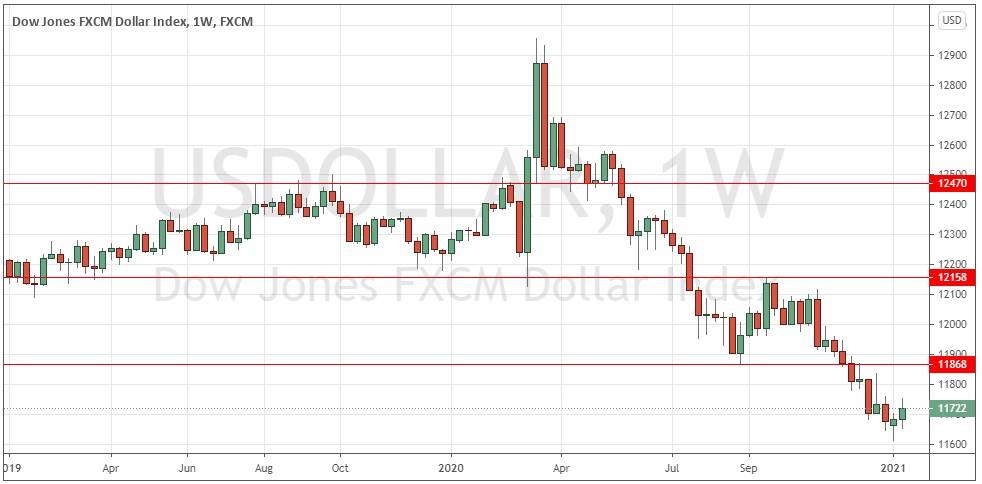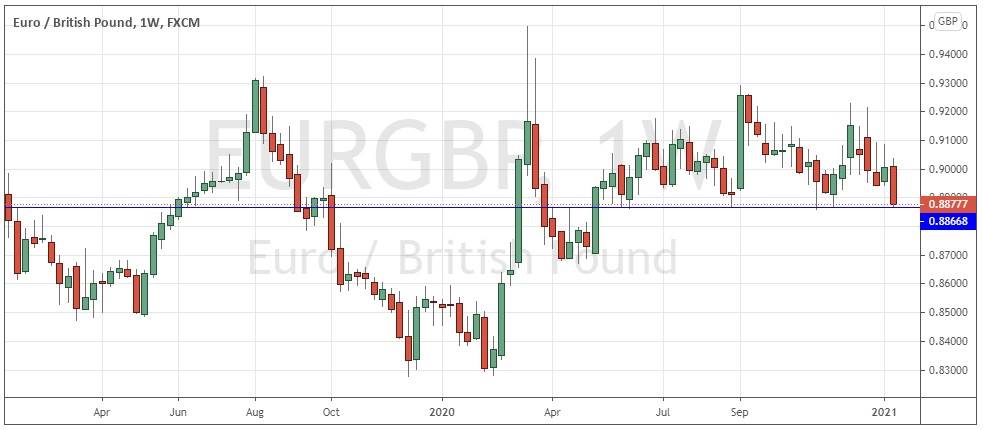The difference between success and failure in Forex trading is very likely to depend mostly upon which currency pairs you choose to trade each week and in which direction, and not on the exact trading methods you might use to determine trade entries and exits.
When starting the trading week, it is a good idea to look at the big picture of what is developing in the market as a whole and how such developments and affected by macro fundamentals and market sentiment.
It is a good time to be trading markets right now, as there are many valid strong trends in favor of stocks and riskier assets.
Big Picture 17th January 2021
In my previous piece last week, I saw the most attractive trade opportunities as long of the S&P 500 Index. I also saw short-term trading opportunities long in Bitcoin (BTC/USD) until the current bubble finally burst.
This was not a great call as the S&P 500 Index fell by 0.92% over the week. The Bitcoin bubble burst, which I was at least correct to warn about, and using a tight stop there last week should have ensure a break-even result on any long trades as the price rose on Monday.
Last week’s Forex market saw the strongest rise in the relative value of the British pound and the strongest fall in the relative value of the euro. There is still a valid, long-term, strong trend against the U.S. dollar meaning it is an attractive time to be trading Forex, as the greenback is the prime driver of the Forex market. However, last week saw the U.S. dollar rise firmly for the second consecutive week, suggesting that trend trades against the dollar need to wait a while.
Fundamental Analysis & Market Sentiment
The headline takeaway is that we are seeing a flow into the U.S. dollar and into safe havens, although most major stock market indices are not far from their all-time highs.
Last week saw President-elect Biden announce a new $2 trillion stimulus plan which will include a $2,000 cash payment to every American adult. Although the Federal Reserve Chair Jerome Powell has described the plan as “appropriate”, markets are a little nervous about it, and it has probably had the effect of pushing up yields on U.S. treasuries which, paradoxically, has sent flow into the U.S. dollar, pushing it up over the past few days. The longer-term effect of Biden’s economic policy is likely to see continuing weakness in the U.S. dollar in line with its existing long-term trend.
Last week again saw a similar level of volatility in the Forex market to the previous week. There is likely to be a higher level of price movement over the coming week due to President-elect Biden’s scheduled inauguration, and central bank input from the European Central Bank, the Bank of Japan and the Bank of Canada.
The major economic data release last week was U.S. retail sales, which came in much worse than had been expected. The number had been expected to remain flat, but retail sales in the U.S. saw a monthly fall of 0.7%, evidence of the continuing impact on the U.S. economy of the wildly out-of-control coronavirus pandemic in the U.S. This data helped boost the U.S. dollar and knock stocks during the final hours of Friday’s session.
Global stock markets remain broadly bullish but are off their highs. Asian stock markets are relatively strong, with the Nikkei 225 outperforming and the Chinese Hang Seng closing at a one-year high. This reflects the relative success Asian countries have had in containing the coronavirus pandemic.
Last week again saw a new record high in the number of daily confirmed coronavirus cases and deaths worldwide as the pandemic continues to advance despite the rollout of vaccination programs. However, both the U.S. and the E.U. are beginning to see slight drops in the average numbers of both deaths and new cases.
The strongest growth in new confirmed cases is happening in Albania, Andorra, Argentina, Belarus, Bolivia, Brazil, Chile, Colombia, Cuba, Dominican Republic, Ecuador, Estonia, Haiti, Honduras, Indonesia, Iran, Israel, Jamaica, Japan, Kazakhstan, Kuwait, Latvia, Lebanon, Lithuania, Malaysia, Mexico, Moldova, Montenegro, Nigeria, North Macedonia, Pakistan, Paraguay, Peru, the Philippines, Portugal, Russia, Senegal, Slovakia, Slovenia, Sri Lanka, Thailand, Tunisia, Ukraine, the U.A.E., Uruguay, and Venezuela.
Several countries have begun vaccination programs. Israel has vaccinated over 25% of its population (including 75% of over-60s) with a first dose of the Pfizer vaccine. The U.A.E. is next with over 18% of its population vaccinated.
Technical Analysis
U.S. Dollar Index
The weekly price chart below shows that the U.S. Dollar Index printed a weakly bullish candlestick last week, for the second consecutive week. This suggests that the dollar may now be due a further bullish retracement against the strong, long-term bearish trend. Overall, next week’s price movement in the U.S. dollar looks marginally likely to be upwards, or at least indecisive. For this reason, it may be better to trade non-U.S. dollar currency crosses over the following week.
EUR/GBP
The British pound was the strongest major currency last week, while the euro was the weakest. We can see that the price of this currency cross has been ranging above the key support level at 0.8866 since May and now looks poised to break below this level for the first time. If this happens, it will be technically significant, and as Brexit has been concluded with a trade deal, price movements in this cross are less likely to be disturbed suddenly by political developments of rumors.
Bottom Line
I see the best likely opportunity in the financial markets this week as short of the EUR/GBP currency cross following a daily close below the support level identified at 0.8866, provided that daily close is within the bottom third of the day’s range.


